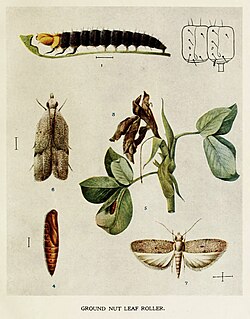
Anarsia euphorodes is a moth of the family Gelechiidae. It is found in China and Taiwan.
Anarsia antisaris is a moth of the family Gelechiidae. It was described by Edward Meyrick in 1913. It is found in South Africa.
Anarsia balioneura is a moth of the family Gelechiidae. It was described by Edward Meyrick in 1921. It is found in Cabo Verde, [[Kenya]], Malawi, Uganda and Zimbabwe.
Anarsia citromitra is a moth of the family Gelechiidae. It was described by Edward Meyrick in 1921. It is found in Mozambique, Kenya, Malawi, Namibia, Mauritius, Réunion, South Africa and Zimbabwe.
Anarsia hippocoma is a moth of the family Gelechiidae. It was described by Edward Meyrick in 1921. It is found in Queensland.
Anarsia leucophora is a moth of the family Gelechiidae. It was described by Edward Meyrick in 1904. It is found in New South Wales.
Copromorpha nesographa is a moth in the Copromorphidae family. It is found on New Ireland.

Erechthias lychnopa is a species of moth in the family Tineidae. This species is endemic to New Zealand. It is classified as "Data Deficient" by the Department of Conservation.

Anarsia ephippias is a moth of the family Gelechiidae. It was described by Edward Meyrick in 1908. It is found in India and Sri Lanka.
Compsoctena scriba is a moth in the family Eriocottidae. It was described by Edward Meyrick in 1921. It is found in Lesotho, Malawi, Mozambique, South Africa, Tanzania, Zambia and Zimbabwe.
Anarsia pensilis is a moth of the family Gelechiidae. It was described by Edward Meyrick in 1913. It is found in Sri Lanka.
Anarsia austerodes is a moth in the family Gelechiidae. It was described by Edward Meyrick in 1918. It is found in Namibia and South Africa.
Anarsia eutacta is a moth in the family Gelechiidae. It was described by Edward Meyrick in 1921. It is found on Java in Indonesia.
Pessograptis cyanactis is a moth in the family Gelechiidae. It was described by Edward Meyrick in 1930. It is found in Pará, Brazil.
Anarsia ulneongensis is a moth in the family Gelechiidae. It was described by Kyu-Tek Park and Margarita Gennadievna Ponomarenko in 1996. It is found in Korea and Japan.
Anarsia idioptila is a moth in the family Gelechiidae. It was described by Edward Meyrick in 1916. It is found in Bengal.
Anarsia melanchropa is a moth in the family Gelechiidae. It was described by Edward Meyrick in 1926. It is found in north-western India.
Anarsia omoptila is a moth in the family Gelechiidae. It was described by Edward Meyrick in 1918. It is found in south India.
Anarsia sagmatica is a moth in the family Gelechiidae. It was described by Edward Meyrick in 1916. It is found in north-western India.
Antiochtha cataclina is a moth in the family Lecithoceridae. It was described by Edward Meyrick in 1923. It is found in Sri Lanka.


